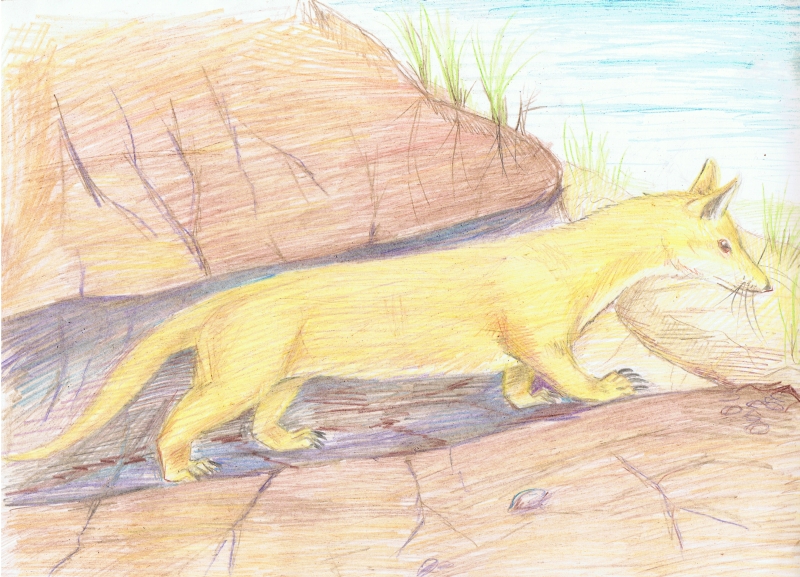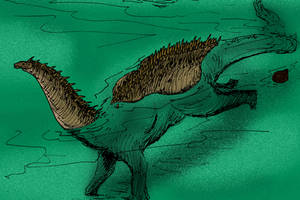ShopDreamUp AI ArtDreamUp
Deviation Actions
Suggested Deviants
Suggested Collections
You Might Like…
Featured in Groups
Description
Common xolot (Anconocyon pratensis)
Order: Carnivors (Carnivora)
Family: Canids (Canidae)
Habitat: North America, meadows and prairies.
Coyote (Canis latrans) was one of the most successful predators of North America. In human epoch it had considerably expanded an area and had partly replaced wolf strongly exterminated at that time. Due to smaller size and variability of behaviour this species had freely adapted to life in anthropogenous landscape. After human disappearance coyote had kept the positions occupied in nature and had fixed its success, having penetrated along Beringian Isthmus to Old World. In North America coyote descendants evolved to animals looking unlike each other such as swift-footed gracile lupardus (Lupardus tenuis) and the hyena-toother (Hyaenognathus macrodens), massive carrion devourer. But, undoubtedly, the most exotic and deviated descendant of coyote is xolot – the unusual underground coyote kind. The name “xolot” descends from the name of Xolotl – Aztec “coyote-headed” god of underground world.
There are some species of this animal living in North America. Common xolot is the most widespread among them. Common xolots inhabit meadows and prairies far from large rivers where there is no danger of flooding. They lead substantially underground habit of life and settle in small colonies in burrow systems dug out in prairies by large rodents. Xolots are omnivores with significant inclination to carnivory, and their food is diverse; they eat food of animal origin (ground birds, lizards, and also rodents – “builders” of their burrows) and vegetative food (roots and tubers of plants, young leaves and unripe seeds of graminoids). Though they rather frequently eat rodents in which holes they settle, xolots do not cause irreparable damage to colonies of rodents. Besides they rather jealously relate to their own territory, and do not let other predators to their home area. Therefore residing of xolots in holes of rodents is favourable for rodents to some extent. Though xolots attack them, they also simultaneously protect them from other predators. Damage caused by xolots to rodents is much less than possible damage other predators can cause to these rodents. Thus, between predatory xolots and their neighbours the certain biological balance is observed.
Common xolot is a medium-sized animal: its length including tail reaches 60 – 70 cm. The fur of this animal is short, rich and velvety, that interferes with its dirtying with ground and sand. Colouring of fur is light enough – usually it has bright sandy color, but there are individual deviations from grey and white up to red and yellow color. Paws of animal are strong, rather short and slightly bent. Xolot runs in its burrows and if necessary can easily dig out its own holes or expand already existing ones. The body of this animal is extended, and ears are rather big and wide, that is obviously atypical for burrowing animal. Anatomic feature of xolots as of separate genus is the presence in their ear of additional skinny membrane which simultaneously improves hearing and protects ear ducts from the ingress of sand and ground. Besides the auricle at underground movement turns back so that dust did not get into acoustic duct. Sight at xolots is rather weak, but the hearing and sense of smell are perfectly advanced. At night xolots go to the ground surface and feed on small animals and berries. They usually get roots and tubers during the tunnel digging.
Xolots live in small colonies numbering up to 10 – 15 individuals, consisting of breeding couple and their posterity. As a rule, males remain in group, and females leave it to settle in other place when reaching sexual maturity. They prefer to move to other colonies, using holes of rodents. These animals are afraid of bright sunlight, and if they appear on ground surface during the resettlement, they try to find any casual shelter.
The female brings posterity once a year. To give birth it arranges shelter in deep and well protected hole. Litter in shelter is made of rests of skins of prey or flocks of furs; the female adds to it a little portion of grass. For disinfection the female brings into the hole bunches of wormwood greenery and other odorous grasses, in order to get rid of parasites. In litter it may be up to 6 – 9 puppies. They remain in shelter during first two months, gradually surveying holes in vicinities of their home. Young animals become sexually mature at the age of one and half years. Life expectancy is about 15 – 16 years.
Order: Carnivors (Carnivora)
Family: Canids (Canidae)
Habitat: North America, meadows and prairies.
Coyote (Canis latrans) was one of the most successful predators of North America. In human epoch it had considerably expanded an area and had partly replaced wolf strongly exterminated at that time. Due to smaller size and variability of behaviour this species had freely adapted to life in anthropogenous landscape. After human disappearance coyote had kept the positions occupied in nature and had fixed its success, having penetrated along Beringian Isthmus to Old World. In North America coyote descendants evolved to animals looking unlike each other such as swift-footed gracile lupardus (Lupardus tenuis) and the hyena-toother (Hyaenognathus macrodens), massive carrion devourer. But, undoubtedly, the most exotic and deviated descendant of coyote is xolot – the unusual underground coyote kind. The name “xolot” descends from the name of Xolotl – Aztec “coyote-headed” god of underground world.
There are some species of this animal living in North America. Common xolot is the most widespread among them. Common xolots inhabit meadows and prairies far from large rivers where there is no danger of flooding. They lead substantially underground habit of life and settle in small colonies in burrow systems dug out in prairies by large rodents. Xolots are omnivores with significant inclination to carnivory, and their food is diverse; they eat food of animal origin (ground birds, lizards, and also rodents – “builders” of their burrows) and vegetative food (roots and tubers of plants, young leaves and unripe seeds of graminoids). Though they rather frequently eat rodents in which holes they settle, xolots do not cause irreparable damage to colonies of rodents. Besides they rather jealously relate to their own territory, and do not let other predators to their home area. Therefore residing of xolots in holes of rodents is favourable for rodents to some extent. Though xolots attack them, they also simultaneously protect them from other predators. Damage caused by xolots to rodents is much less than possible damage other predators can cause to these rodents. Thus, between predatory xolots and their neighbours the certain biological balance is observed.
Common xolot is a medium-sized animal: its length including tail reaches 60 – 70 cm. The fur of this animal is short, rich and velvety, that interferes with its dirtying with ground and sand. Colouring of fur is light enough – usually it has bright sandy color, but there are individual deviations from grey and white up to red and yellow color. Paws of animal are strong, rather short and slightly bent. Xolot runs in its burrows and if necessary can easily dig out its own holes or expand already existing ones. The body of this animal is extended, and ears are rather big and wide, that is obviously atypical for burrowing animal. Anatomic feature of xolots as of separate genus is the presence in their ear of additional skinny membrane which simultaneously improves hearing and protects ear ducts from the ingress of sand and ground. Besides the auricle at underground movement turns back so that dust did not get into acoustic duct. Sight at xolots is rather weak, but the hearing and sense of smell are perfectly advanced. At night xolots go to the ground surface and feed on small animals and berries. They usually get roots and tubers during the tunnel digging.
Xolots live in small colonies numbering up to 10 – 15 individuals, consisting of breeding couple and their posterity. As a rule, males remain in group, and females leave it to settle in other place when reaching sexual maturity. They prefer to move to other colonies, using holes of rodents. These animals are afraid of bright sunlight, and if they appear on ground surface during the resettlement, they try to find any casual shelter.
The female brings posterity once a year. To give birth it arranges shelter in deep and well protected hole. Litter in shelter is made of rests of skins of prey or flocks of furs; the female adds to it a little portion of grass. For disinfection the female brings into the hole bunches of wormwood greenery and other odorous grasses, in order to get rid of parasites. In litter it may be up to 6 – 9 puppies. They remain in shelter during first two months, gradually surveying holes in vicinities of their home. Young animals become sexually mature at the age of one and half years. Life expectancy is about 15 – 16 years.
Image size
800x577px 395.27 KB
© 2011 - 2024 AlexSone
Comments7
Join the community to add your comment. Already a deviant? Log In
So basically this is like a badger, built low to the ground and elongated to fit though animal burrows?

































